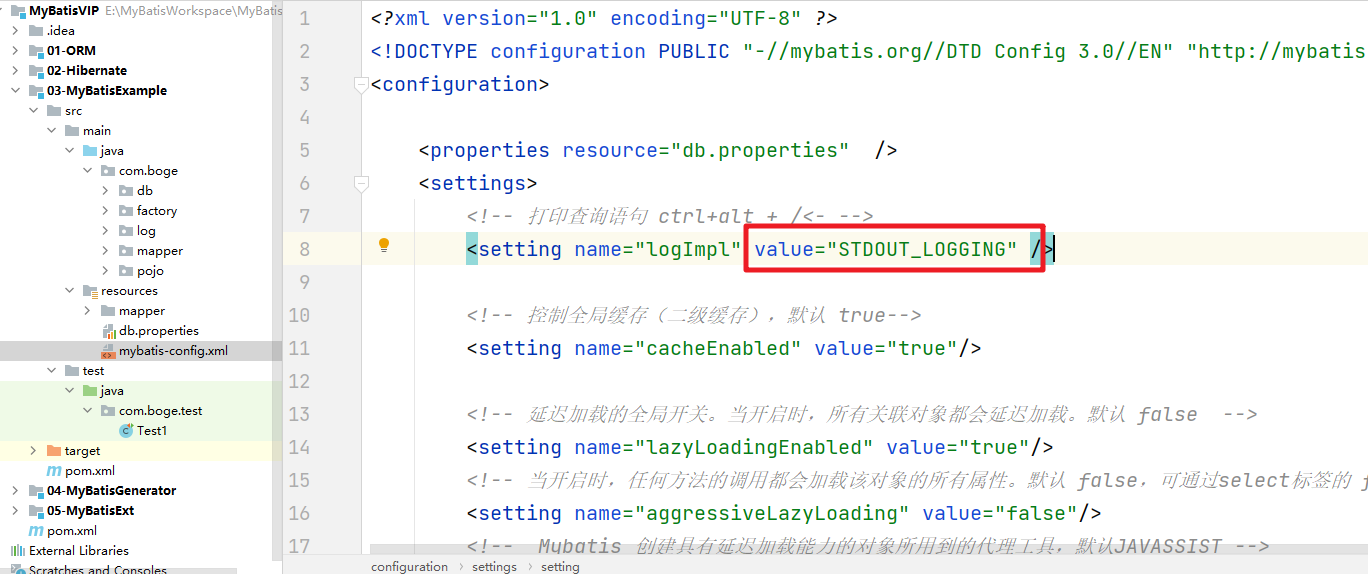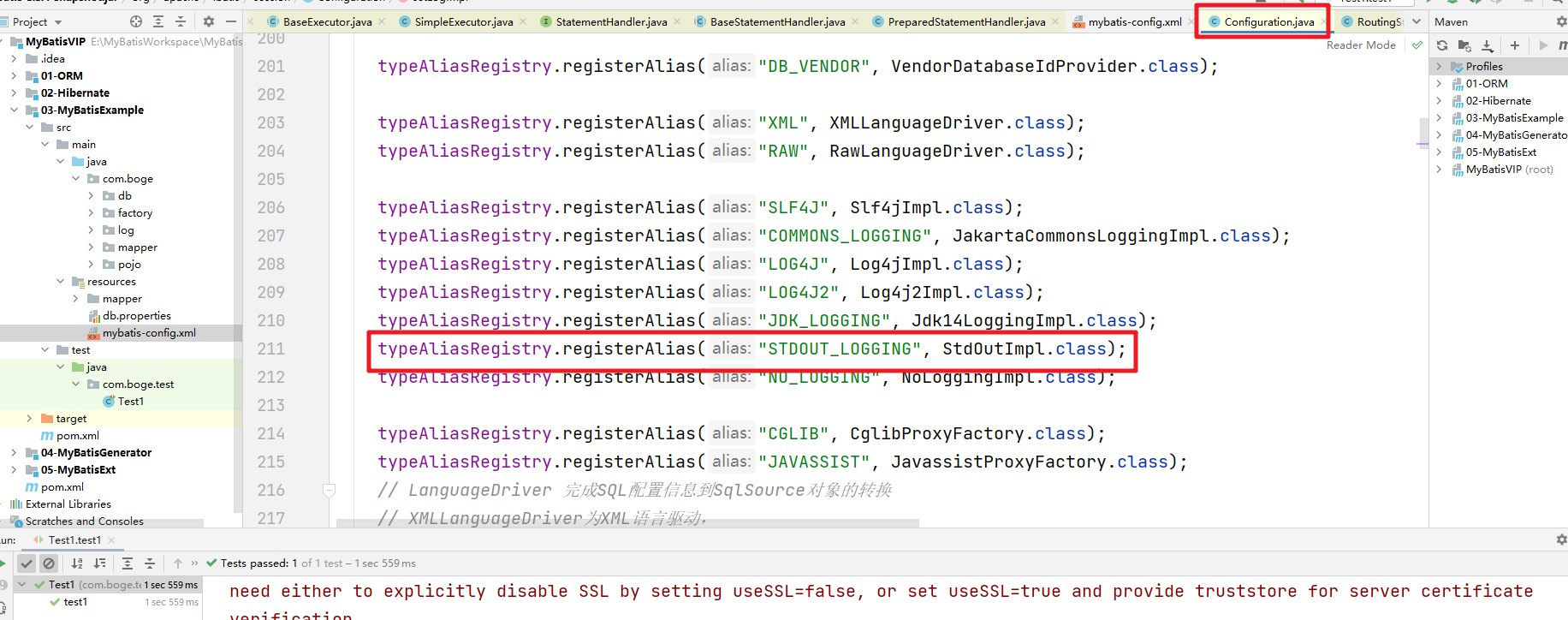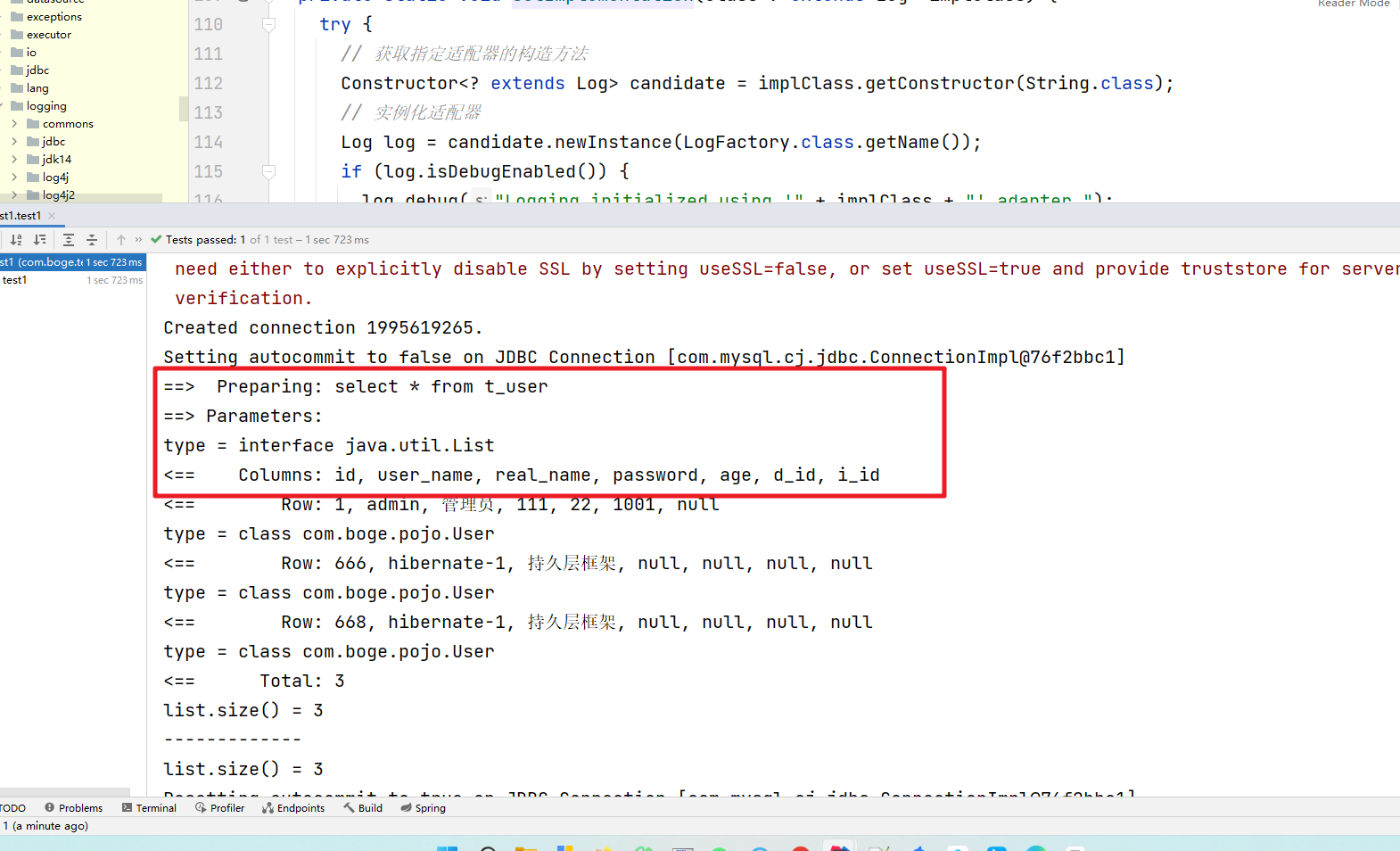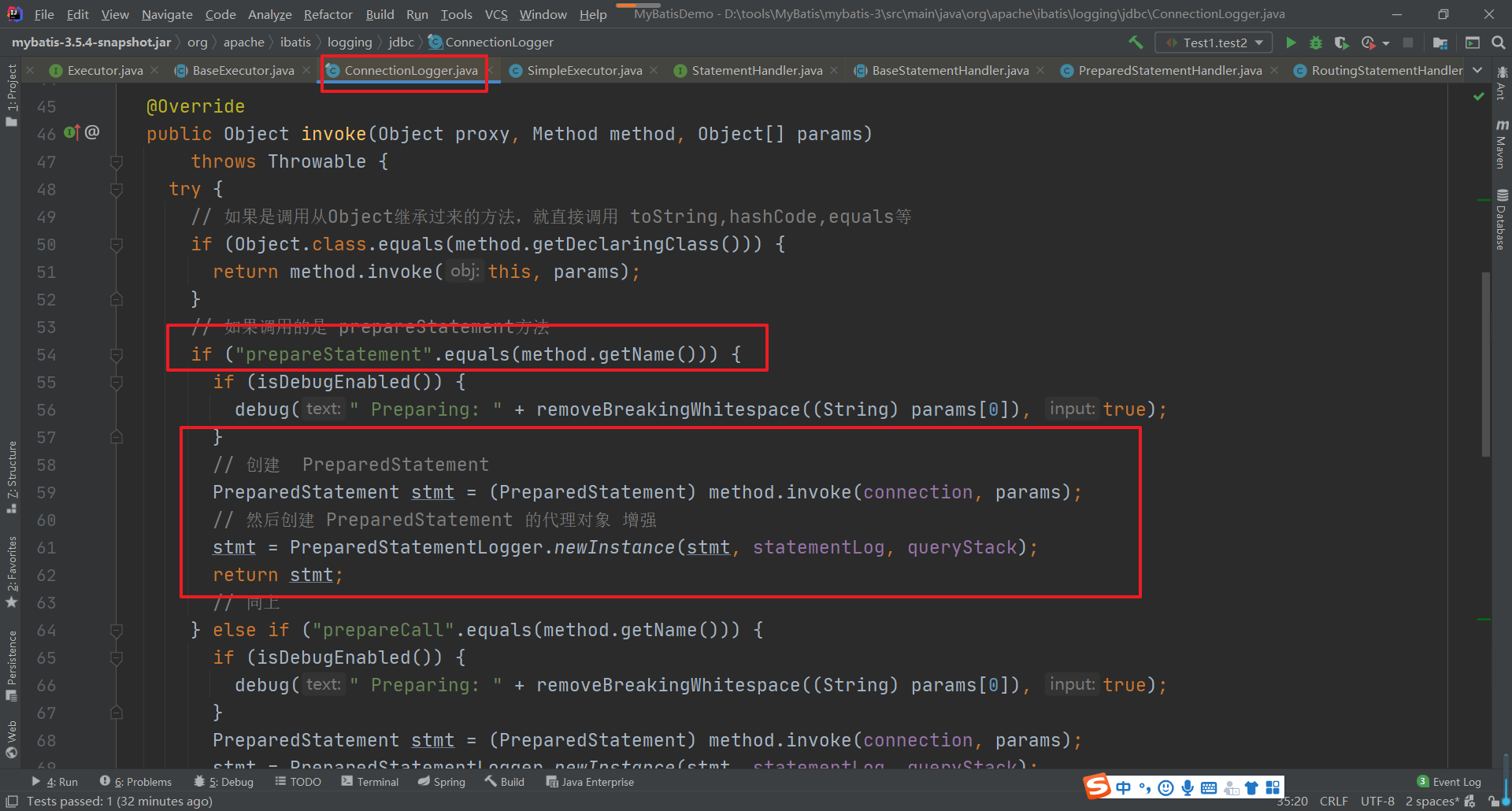前言
日志在我们开发过程中占据了一个非常重要的地位,是开发和运维管理之间的桥梁,在Java中的日志框架也非常多,Log4j、Log4j2、slf4j等,这些工具对外的接口也都不尽相同,为了统一这些工具,MyBatis定义了一套统一的日志接口供上层使用,实现了对slf4J、commonsLoging、Log4J2、Log4J和JdkLog等第三方日志框架进行集成。
Log
Log接口中定义了四种日志级别,相比较其他的日志框架的多种日志级别显得非常的精简,但也能够满足大多数常见的使用了
public interface Log {
boolean isDebugEnabled();
boolean isTraceEnabled();
void error(String s, Throwable e);
void error(String s);
void debug(String s);
void trace(String s);
void warn(String s);
}
LogFactory
LogFactory是一个日志工厂,用于创建和管理日志对象。它提供了一个静态方法getLogger,用于获取指定类的日志对象,并进行日志记录。

在LogFactory类加载时会执行其静态代码块,其逻辑是按序加载并实例化对应日志组件的适配器,然后使用LogFactory.logConstructor这个静态字段,记录当前使用的第三方日志组件的适配器。
日志应用
在MyBatis系统启动的时候日志框架选择是根据全局配置文件中设置对应的日志类型。

这个"STDOUT_LOGGING"是怎么来的呢?在Configuration的构造方法中设置了各个日志实现的别名。

然后在解析全局配置文件的时候就会处理日志的设置
private void loadCustomLogImpl(Properties props) {
// 获取 logImpl设置的 日志 类型
Class<? extends Log> logImpl = resolveClass(props.getProperty("logImpl"));
// 设置日志
configuration.setLogImpl(logImpl);
}
public void setLogImpl(Class<? extends Log> logImpl) {
if (logImpl != null) {
this.logImpl = logImpl; // 记录日志的类型
// 设置 适配选择
LogFactory.useCustomLogging(this.logImpl);
}
}
自己设置的会覆盖掉默认的sl4j日志框架的配置。
JDBC 日志
当开启了 STDOUT的日志管理后,执行SQL操作时在控制台中可以打印出相关的日志信息

日志信息是怎么打印出来的?在MyBatis中的日志模块中包含了一个jdbc包,它并不是将日志信息通过jdbc操作保存到数据库中,而是通过JDK动态代理的方式,将JDBC操作通过指定的日志框架打印出来。
BaseJdbcLogger
BaseJdbcLogger是一个抽象类,它是jdbc包下其他Logger的父类。继承关系如下

从图中也可以看到4个实现都实现了InvocationHandler接口。属性含义如下
// 记录 PreparedStatement 接口中定义的常用的set*() 方法
protected static final Set<String> SET_METHODS;
// 记录了 Statement 接口和 PreparedStatement 接口中与执行SQL语句有关的方法
protected static final Set<String> EXECUTE_METHODS = new HashSet<>();
// 记录了PreparedStatement.set*() 方法设置的键值对
private final Map<Object, Object> columnMap = new HashMap<>();
// 记录了PreparedStatement.set*() 方法设置的键 key
private final List<Object> columnNames = new ArrayList<>();
// 记录了PreparedStatement.set*() 方法设置的值 Value
private final List<Object> columnValues = new ArrayList<>();
protected final Log statementLog;// 用于日志输出的Log对象
protected final int queryStack; // 记录了SQL的层数,用于格式化输出SQL
ConnectionLogger
ConnectionLogger的作用是记录数据库连接相关的日志信息,在实现中是创建了一个Connection的代理对象,在每次Connection操作的前后我们都可以实现日志的操作。
public final class ConnectionLogger extends BaseJdbcLogger implements InvocationHandler {
// 真正的Connection对象
private final Connection connection;
private ConnectionLogger(Connection conn, Log statementLog, int queryStack) {
super(statementLog, queryStack);
this.connection = conn;
}
@Override
public Object invoke(Object proxy, Method method, Object[] params)
throws Throwable {
try {
// 如果是调用从Object继承过来的方法,就直接调用 toString,hashCode,equals等
if (Object.class.equals(method.getDeclaringClass())) {
return method.invoke(this, params);
}
// 如果调用的是 prepareStatement方法
if ("prepareStatement".equals(method.getName())) {
if (isDebugEnabled()) {
debug(" Preparing: " + removeBreakingWhitespace((String) params[0]), true);
}
// 创建 PreparedStatement
PreparedStatement stmt = (PreparedStatement) method.invoke(connection, params);
// 然后创建 PreparedStatement 的代理对象 增强
stmt = PreparedStatementLogger.newInstance(stmt, statementLog, queryStack);
return stmt;
// 同上
} else if ("prepareCall".equals(method.getName())) {
if (isDebugEnabled()) {
debug(" Preparing: " + removeBreakingWhitespace((String) params[0]), true);
}
PreparedStatement stmt = (PreparedStatement) method.invoke(connection, params);
stmt = PreparedStatementLogger.newInstance(stmt, statementLog, queryStack);
return stmt;
// 同上
} else if ("createStatement".equals(method.getName())) {
Statement stmt = (Statement) method.invoke(connection, params);
stmt = StatementLogger.newInstance(stmt, statementLog, queryStack);
return stmt;
} else {
return method.invoke(connection, params);
}
} catch (Throwable t) {
throw ExceptionUtil.unwrapThrowable(t);
}
}
/**
* Creates a logging version of a connection.
*
* @param conn - the original connection
* @return - the connection with logging
*/
public static Connection newInstance(Connection conn, Log statementLog, int queryStack) {
InvocationHandler handler = new ConnectionLogger(conn, statementLog, queryStack);
ClassLoader cl = Connection.class.getClassLoader();
// 创建了 Connection的 代理对象 目的是 增强 Connection对象 给他添加了日志功能
return (Connection) Proxy.newProxyInstance(cl, new Class[]{Connection.class}, handler);
}
/**
* return the wrapped connection.
*
* @return the connection
*/
public Connection getConnection() {
return connection;
}
}
其他几个xxxxLogger的实现和ConnectionLogger几乎是一样。
应用实现
在执行SQL语句前需要获取Statement对象,而Statement对象是通过Connection获取的,所以在SimpleExecutor中就可以看到相关的代码
private Statement prepareStatement(StatementHandler handler, Log statementLog) throws SQLException {
Statement stmt;
Connection connection = getConnection(statementLog);
// 获取 Statement 对象
stmt = handler.prepare(connection, transaction.getTimeout());
// 为 Statement 设置参数
handler.parameterize(stmt);
return stmt;
}
创建Connection的日志代理对象
protected Connection getConnection(Log statementLog) throws SQLException {
Connection connection = transaction.getConnection();
if (statementLog.isDebugEnabled()) {
return ConnectionLogger.newInstance(connection, statementLog, queryStack);
} else {
return connection;
}
}
@Override
protected Statement instantiateStatement(Connection connection) throws SQLException {
String sql = boundSql.getSql();
if (mappedStatement.getKeyGenerator() instanceof Jdbc3KeyGenerator) {
String[] keyColumnNames = mappedStatement.getKeyColumns();
if (keyColumnNames == null) {
return connection.prepareStatement(sql, PreparedStatement.RETURN_GENERATED_KEYS);
} else {
return connection.prepareStatement(sql, keyColumnNames);
}
} else if (mappedStatement.getResultSetType() == ResultSetType.DEFAULT) {
return connection.prepareStatement(sql);
} else {
return connection.prepareStatement(sql, mappedStatement.getResultSetType().getValue(), ResultSet.CONCUR_READ_ONLY);
}
}
在执行 prepareStatement 方法的时候会进入进入到ConnectionLogger的invoker方法中

总结
MyBatis 日志模块提供了丰富的日志级别和日志输出方式,可以根据需要进行配置。通过日志模块,可以方便地跟踪 SQL 语句的执行情况,以及定位数据库操作中出现的问题。